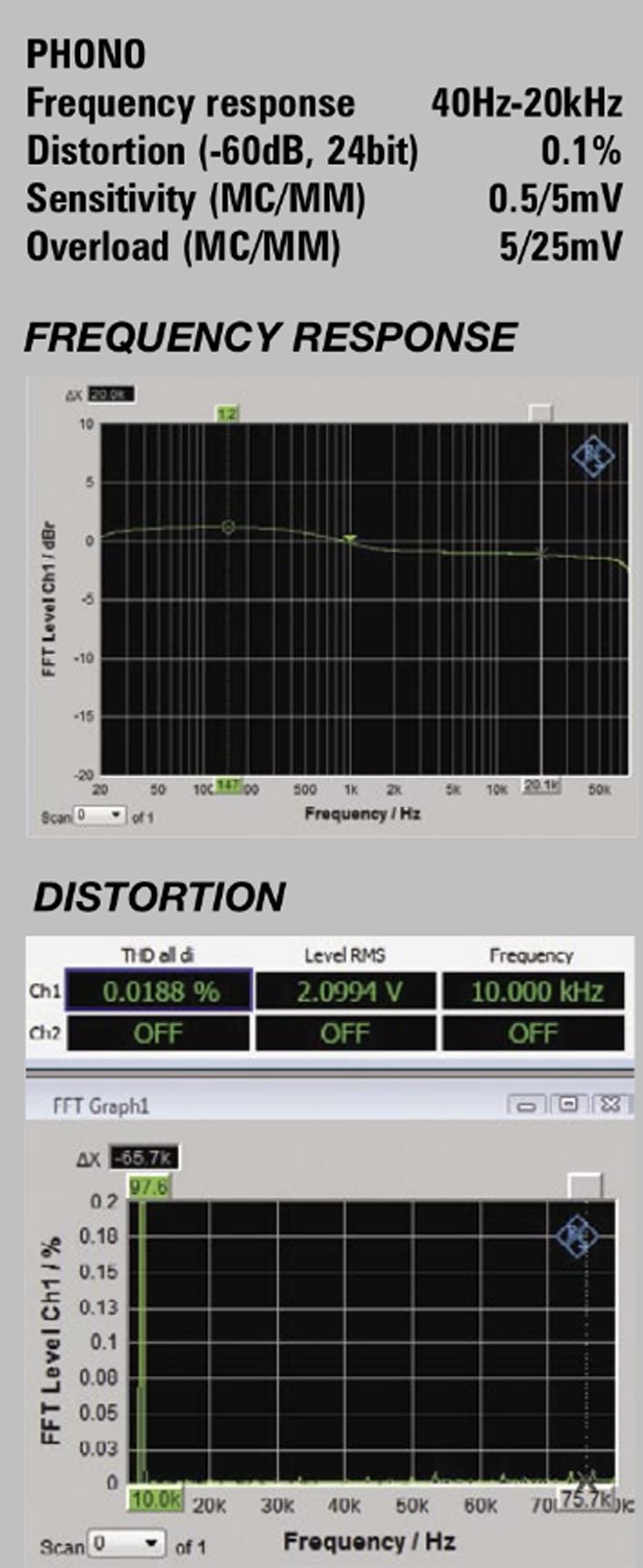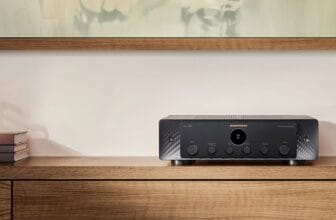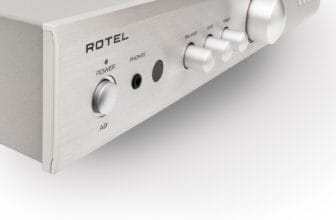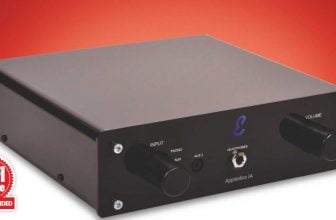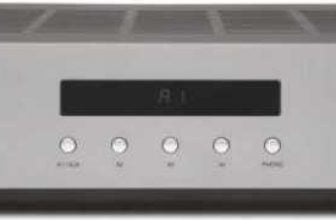HIFI ROSE RSA180 Review – Punk Power
A powerful steam-punk styled amplifier, reviewed by Noel Keywood. Read our HIFI ROSE RSA180 Review.
The undeniably novel RA 180 amplifier from HiFi Rose (Korea) is classic steam punk at front and almost mystifying at rear. What are all those loudspeaker sockets for? I’ll tell you, plus a lot more that puts this £ amplifier into a category of its own.
Here are the basics.The RA 180 has four hi-tech Class D modules inside, that throw out 200W each.There are wideband amplifiers for Left and Right channels, plus additional treble amplifiers also for Left and Right, that come with frequency and level controls.Yes, it gets complicated – and I haven’t started!
Staying with the basic design ethos, this is to provide independent amplifiers for the bass and treble sections of biwire loudspeakers (bi-amping), should you wish to do so. If not then the two amplifiers of each channel can be switched to BTL mode (bridged) to double available power, giving 400W. There were so many issues here I’ll have to cover them later.
This explains why there are four pairs of chunky loudspeaker sockets, but HiFi Rose fit eight pairs in total so the RA 180 can connect to A or B loudspeakers – if not at the same time.
In the spirit of steam-punkedness, HiFi Rose fit a phono stage with a bewildering array of adjustments able to correctly equalise discs from long, long ago, including 78s. Most will want to use RIAA here, clearly marked. A small slide switch at rear selects MM or MC cartridge.
These unusual features of the RA 180 explain all the front panel controls, if not the adornments. There are bass and treble tone controls that can be switched out, a‘high-pass’ tuning section that can be switched out, a complex Phono preamp section, a slide control for channel balanced and – yes – that funky volume control with its gears, back illumination and physical pointer to show volume level. Whoa! Behind lies a motorised potentiometer that can be remote controlled.
This is not a digital amplifier in that there are no digital inputs, including Bluetooth. Some of the cut-off slopes and filter behaviours looked digital to me during measurement, suggesting internal ADC/DAC but no tell-tale antialiasing filtering appeared below 100kHz so I could not be sure. The tone control behaviours were like nothing I have seen before, and they even had influence when switched out (!), leaving me a bit baffled. An unusual topology where the Bypass switch doesn’t do it.
The handbook has a ‘wi-fi settings’ section but there’s no wi-fi hidden inside that my router, ‘phone or computer could detect.
Also strange was that the amplifier’s main wideband modules did not measure flat with tone control switched out (Bypass) and similarly neither did the HF (treble) modules when set to flat (Bypass). Running in BT (bridged) mode gave the same result.
Output from the HF module could be adjusted for frequency and degree of attenuation, but there was no extra gain available to flatten frequency response. So this is a not an amplifier with flat frequency response; it is tailored to have a warm sound balance. The HF module needs more gain so it can be tweaked to increase HF as well as decrease it, so users at least have that option when biamping.
Why would anyone want to tweak the high-pass frequency of a tweeter feed when the crossover network in a loudspeaker has been designed to do this correctly? I don’t know; I fail to understand the thinking here.And since the main amplifier is wideband with no low-pass filtering there is no potential for active filtering. It’s all a bit peculiar in engineering terms, if not in fiddle factor. I carefully read the supplied instruction manual and website info but was unenlightened.
As HiFi Rose claim, their Class D amplifier modules work very well our measurements showed, suffering none of the usual problems of Class D, notably high frequency switching distortion, load dependant frequency response and current slewing. They even tolerated an inductive load, so top marks here. It’s a sophisticated Class D amplifier, powered by a chunky switch-mode power supply our internal shots show.
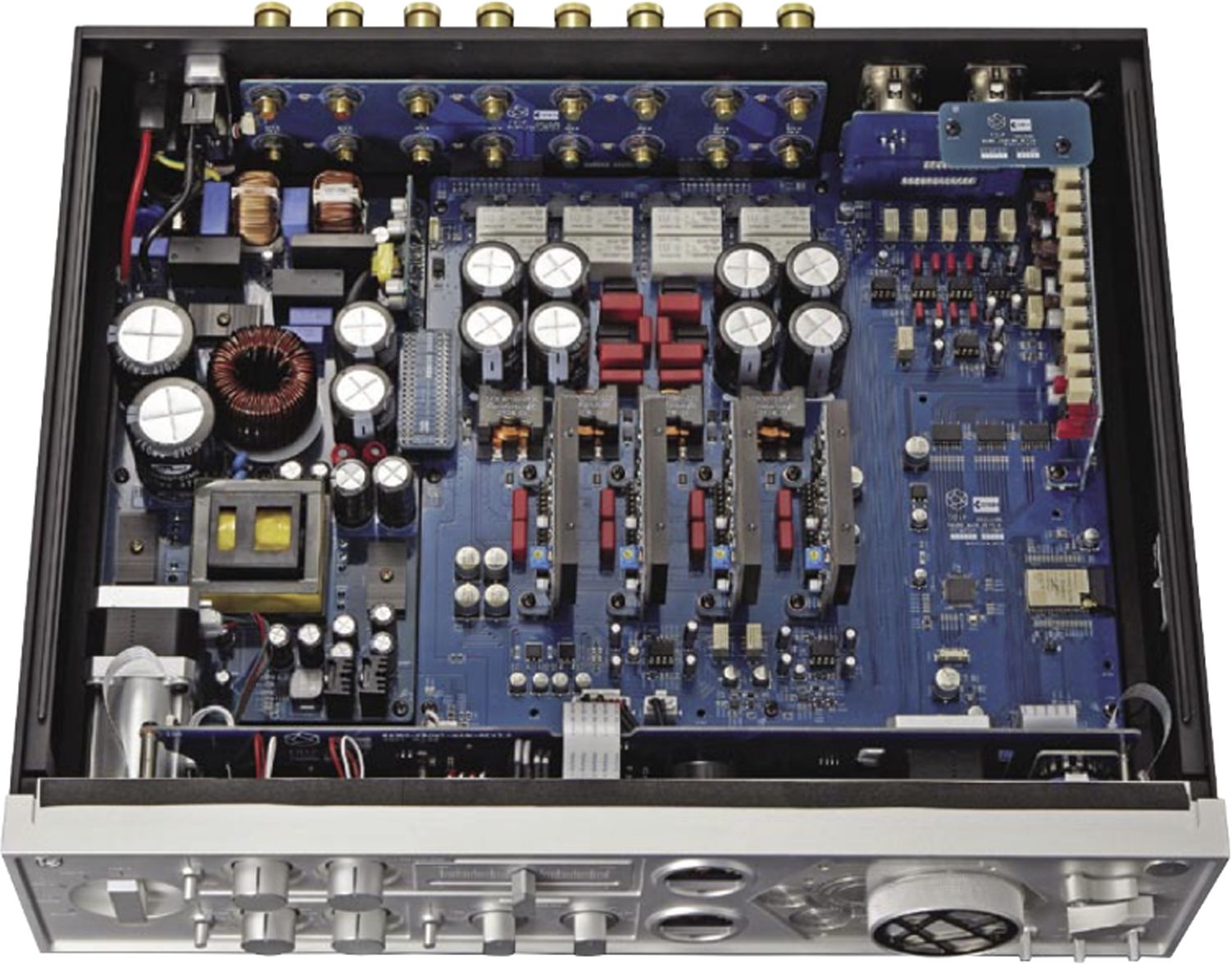
At centre lie four Class D amplifier modules, above them output network inductors and capacitors vital to Class D. At left is a large switch-mode power supply and at right the preamplifier board.
This is a solidly built and well finished unit, weighing a substantial I 6.7kg, measuring 430mm wide, I 30mm high and 380mm deep. There is a remote control with volume and input selection, power on/off and mute, but no filter functionality for settee tweaking.
The gears, wheels and lights looked and felt good, all slickly smooth. Not quite the authenticity of my valve amplifiers but I get the feeling HiFi Rose were trying to invoke this idiom.The small meters show input level, not output power, because there is a low-ish input overload ceiling of IV line and 3V balanced.
SOUND QUALITY
The RA 180 was connected to our Martin Logan ESL-X hybrid electrostatic loudspeakers through Chord Company Signature Reference screened loudspeaker cables. Sources were our Oppo BDP-205D CD player with its ESS ES9038Pro DAC, plus a MacBook Pro connected to this player via USB for hi-res / DSD replay. Connection to the HiFi Rose was through Chord Epic balanced analogue cables. I started out using the wideband main amplifiers only.
Immediately obvious was a silky smooth presentation quite the opposite of traditional Class D with its ‘broken glass” treble, as if someone somewhere was trying to ensure that subjectively the amplifier could or would never be labelled “Class D”. There were nicely placed fine details on a wide sound stage that had both depth and a good sense of atmosphere. It all came across as smooth and easy going, quite lovely in its own way, being a relaxing delivery rather than a challenging one. Switching in the tone controls to add some sparkle up top was no great success: there was more treble but not of liquid clarity.
There were – inevitably – occasions when the contrived tonal balance became obvious. With bass heavy tracks such as Loreena McKennitt’s Gates of Istanbul the opening bass line was close to overwhelming.This also brought attention to bass quality that was a tad soft. There was a solution: it is to turn treble up by a very small amount (its action is coarse), not turn bass down.
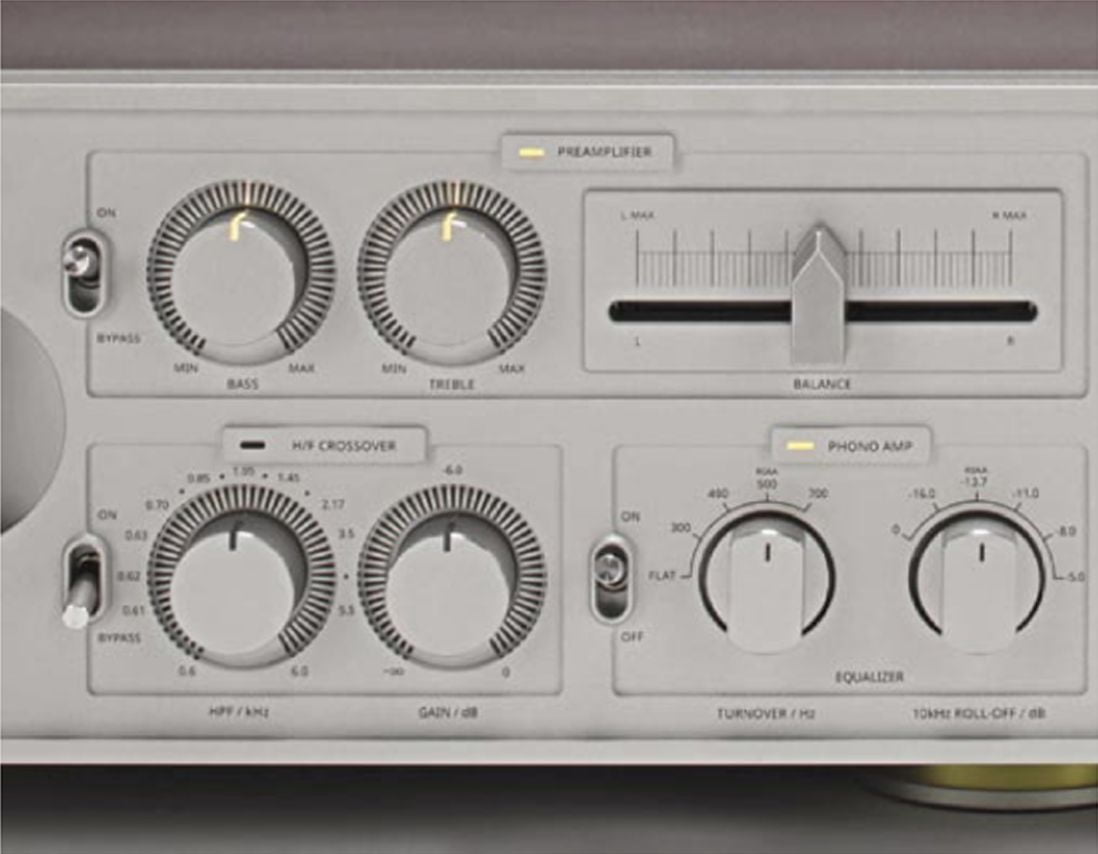
At top left, bass and treble tone controls with a Bypass switch that did not fully bypass them. Below are high-pass controls for the HF amplifier, again with Bypass switch. The Phono input (bottom right) has LF and HF adjustment to provide a wide variety of commercial equalisations from the past.
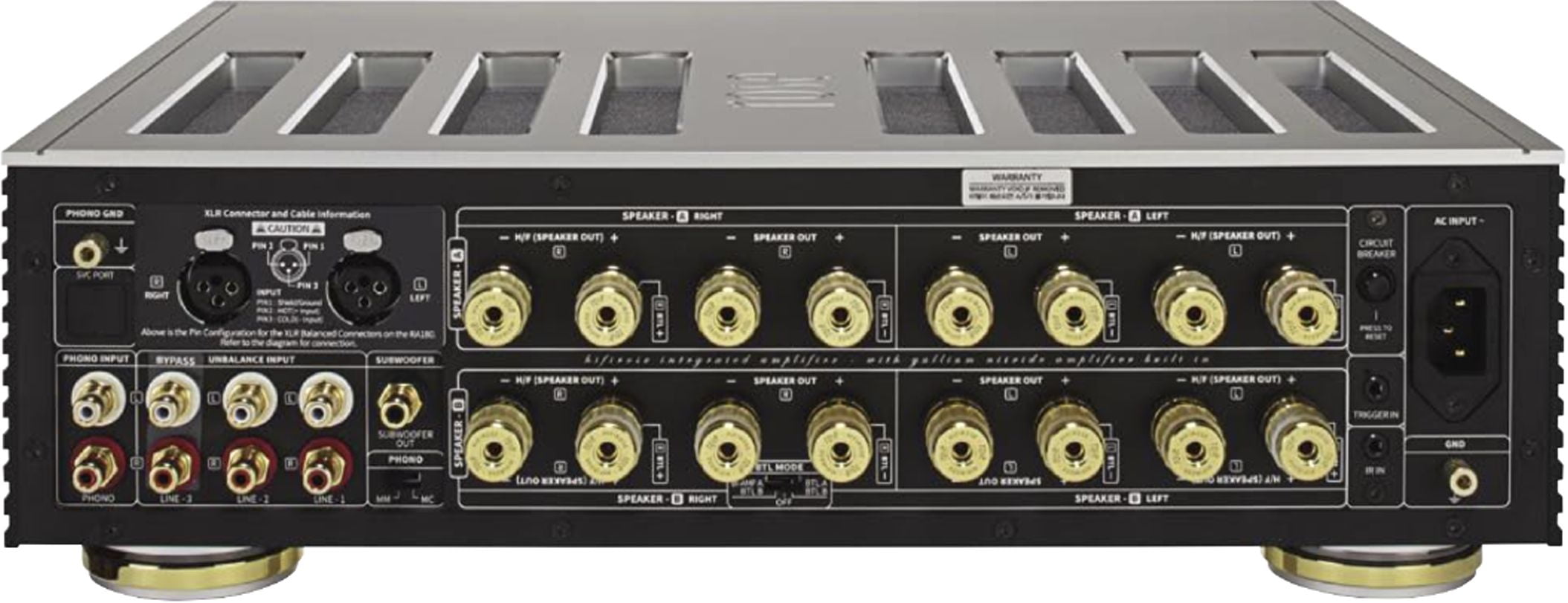
Loudspeaker sockets for bi-amped A and B channels occupy much of the rear. At left are balanced inputs (top) and line inputs (below), plus a single subwoofer output. The BTL mode switch lies beneath the speaker sockets.
Adding an extra set of cables to run the loudspeakers biamped made little difference, with identical tonal balance favouring low frequencies.
CONCLUSION
If the Bypass functions of this amplifier worked properly to
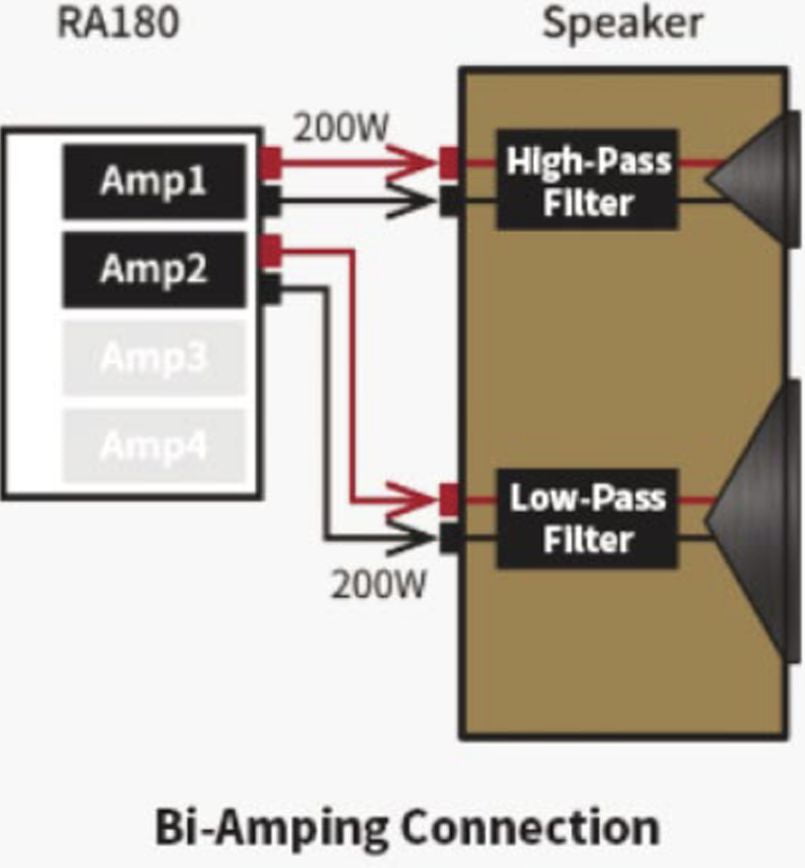
With bi-amping the ‘HF’ amp with adjustable high-pass filter (Amp 1) feeds the tweeter of a two-way ‘speaker, and the ‘Main’ amp (Amp 2) feeds the bass/mid. unit.
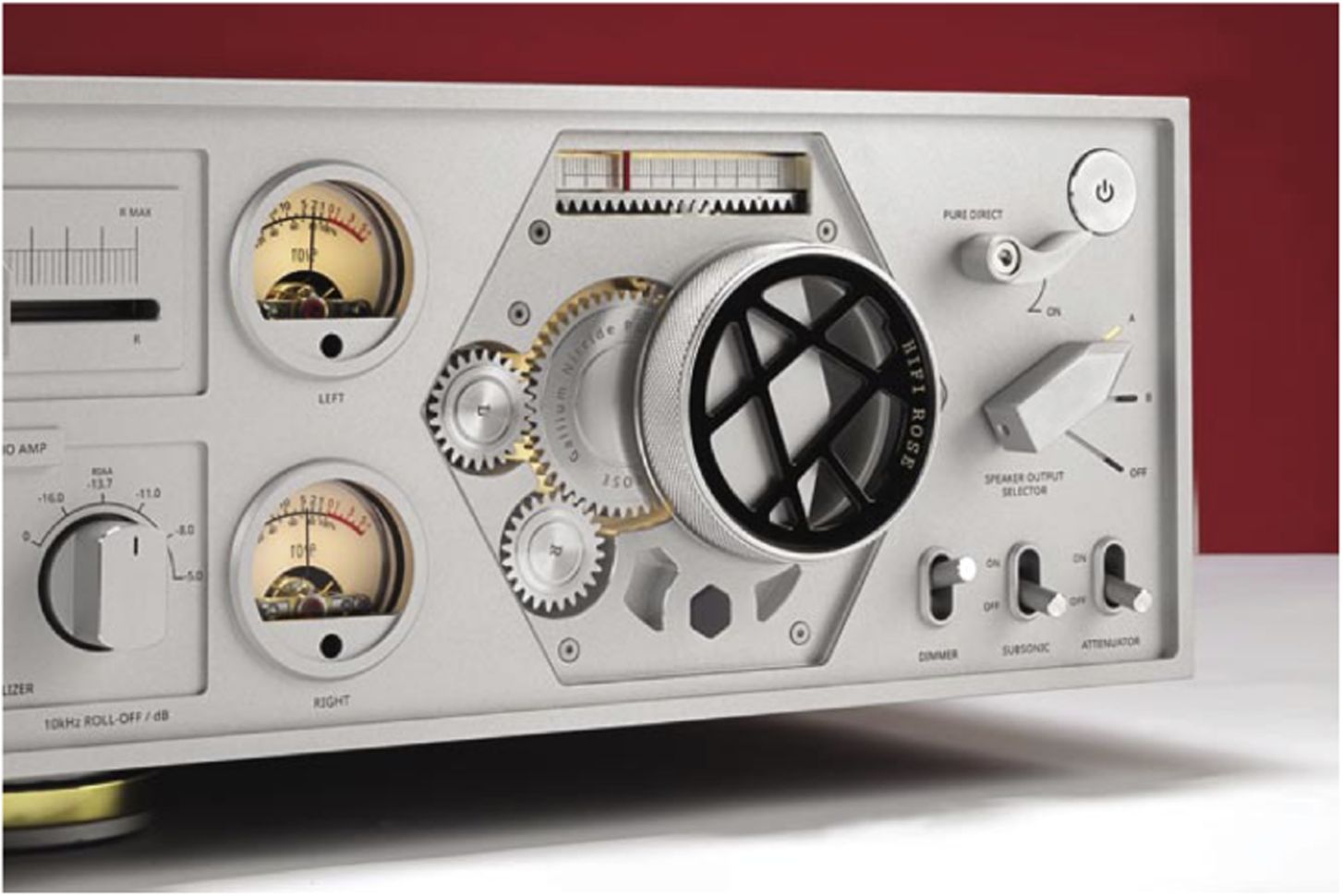
The large volume control drives a main gear that in turn spins two secondary gears (L & R). It also drives linear dial at top to show volume level. At left the meters show input level to warn of overload.
give flat frequency response it would have helped make it more acceptable I feel.
But perhaps I am missing the point.With its funky appearance comes a funky Beats-style sound that’s aimed at a generation intrigued by gears, wheels and things that go round and round. There’s a lot to attract in this
package, including strong bass.
If you are drawn by the RA 180’s steam punk style and a warm easy sound, reminiscent of the period it seemingly represents, then it has no competition and is No I in a field of one. But with obvious engineering weaknesses easily curable, at best 4 Globes from an audiophile point of view.
MEASURED PERFORMANCE
The HiFi Rose RA180 amplifier produced 200 Watts into 8 Ohms and the same into 4 Ohms due to current limiting kicking in. So as claimed this is a 200W amplifier. There is a BTL switch at rear that can double power (400W) by bridging the amplifiers. I tested with this set to Off.
Frequency response wasn’t flat from the broadband output sockets even with bass and treble controls Bypassed (and Pure Direct on). There is +1 dB of bass shelf- lift below 1kHz and -1dB cut above, enough to give a warm sound. Strangely, the controls still had some effect in Bypass mode, turning treble up reduced it! In active mode their lift and cut characteristics were massive. Frequency response could be brought near to flat with controls On and treble turned up slightly.
Anyone buying this amplifier would probably choose to use ‘Main speaker out’ to the bass section of a bi-wire loudspeaker, and ‘HF speaker out’ to the treble unit, as per the copmpany’s diagram. However, there is no additional gain available in the HF section to raise treble level, the Gain control only provides attenuation (which is why maximum is marked 0dB).
Surprisingly, the phono section set to MM or MC did measure flat with the Turnover controls set to RIAA (not Flat) and the preamp switched on, but Subsonic off. Switching subsonic on introduces steep bass cut below 50Hz. Sensitivity and overload figures were satisfactory, the meters showing input level past which distortion rises, 0dB (full scale) being a low 1V via Line in and 3V via balanced in, above which distortion HiFi Rose slowly, as If a peak compression circuit or similar was operating. This also resulted in inconsistent distortion behaviour with high level input signals, the sign of a running overload protection strategy, likely at chip level.
The RA180 has a non-flat response so will sound different to the norm, softer and with stronger bass. This apart it measured acceptably well. NK
AMPLIFIER
Power (8 ohm) 200W
Frequency response 4Hz-98kHz
Distortion (10kHz, 1W, 4ohm) 0.03%
Noise (IEC A) -98dB
Sensitivity 200mV
